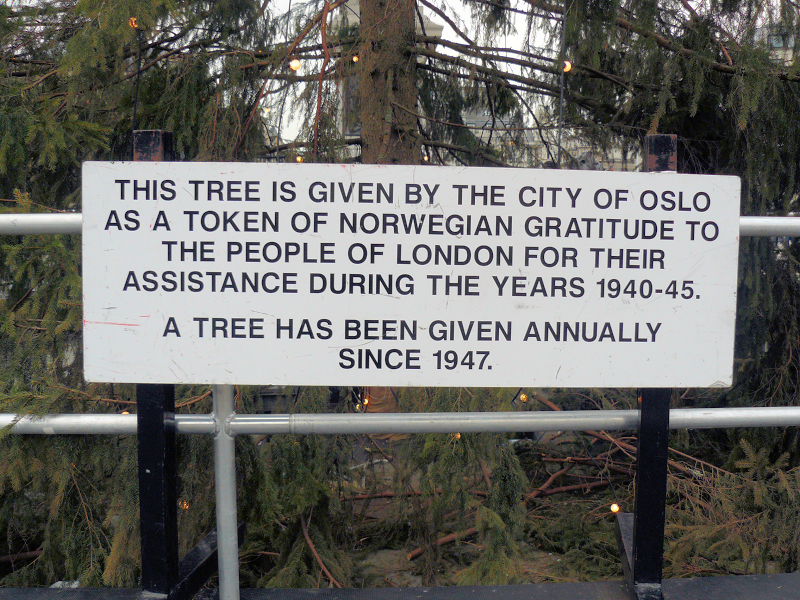Wood of Value is an observational documentary about the journey one spruce tree makes from the forests of Norway to the city of London. The annual tradition of sending a Christmas tree across the North Sea has been maintained for more than 60 years and is to this day very much alive:
[youtube=http://www.youtube.com/watch?v=tzckFfHSYY0]
Photo of the filmmakers:
From left; Bjorn Bratberg, B-camera operator Ben Jones and sound recordist Sara LimaInterview with Bjørn Bratberg ( Director)
TM: Who are you?
 My name is Bjørn Bratberg. I am a freelance cinematographer (cameraman), based in London. I work on various projects, from film drama and documentary to music videos and commercials. Originally, I am from Norway, but I studied film in London between 2000-2005 and started to find work here, so I stayed.
My name is Bjørn Bratberg. I am a freelance cinematographer (cameraman), based in London. I work on various projects, from film drama and documentary to music videos and commercials. Originally, I am from Norway, but I studied film in London between 2000-2005 and started to find work here, so I stayed.
TM: Why did you make the movie about a christmas-tree?
As I live in London, I have walked past the Norwegian Christmas tree many times during December every year. The tree has historical and political roots a long way back – since the 2nd world war. For the average Norwegian, I think that the Trafalgar Christmas tree is tremendously important. As much as we like to maintain traditions and focus on generosity and friendship, Norwegians like to think about themselves as people who is close to nature. The fact that we appreciate spending time in free nature ourselves, adds to the importance and value of the ‘gift’ we are giving to the people of London.
For the idea of the film; I just thought it would be interesting to see a piece of nature, brought from is native environment across the sea to the London city centre. It would be the tradition of the Christmas tree, just on a larger scale. Why do people bring a piece of nature in to their own home?
Also for the film; the contrasting environments (forest, sea, city) seemed very interesting – not to forget the mentality of people and the difference of culture.
TM: Did you use an old camera or was it a digital treatment for some of the scenes?
Regarding the shooting format used (camera type); it was mixed. The majority was 16mm film, but some 35mm film and super 8 mm film. The journey of the tree (across the sea) was filmed on digital video.
The idea with the different formats was to create a different feel to each of the stages of the tree; the day when they cut the tree on 16mm film. Film has a very ‘organic’ and ‘natural’ feel, which I thought suited the forest setting. Also, I wanted to create a certain sense of timelessness or nostalgia – the tradition/gesture of sending a tree to London has been going on for over 60 years (which shooting on film will give you).
For a few sections we also used the super 8mm format, which has a very rough look. I used it to create a sense of memory – how you remember what happened long ago and to create a nostalgic mood.
It was a matter of pure practicality that the journey of the tree was filmed with digital video, but the clean and ‘scientific’ look seemed to suit the environment of the ship etc.
The last part of the film, with the small newsreel (again to create a sense of timelessness) and the portraits pf people at Trafalgar Square, was filmed with 35mm film – the grandest of film formats – to celebrate the end of the journey for the tree.
TM: What is your opinion about killing trees just for the celebration of Jesus Christ’s-birth? (Well, they needed some wood for the cross anyway…)
As I said above, the tradition of Christmas trees is an odd one. But if it can get people to appreciate the beauty of nature more or bring them out of the ‘comfort-zone’ of the modern society – I think it’s good. Humans are also a part of nature, I think a lot of people forget that.
TM: Do you think your work will change this world? Why and how?
Hehehe… no I don’t think so. But for those who have watched this film: Next time they see a Christmas tree, they might start thinking about where it comes from, how many years old it is and how it was transported. You might see the tree more as a piece of nature rather than purely a Christmas decoration.
TM: What’s your next project?
I am working on an idea about Brazilian football and ideology/mentality of people.
TM: Where are you going to plant a Tree?
My family has a cabin in the Norwegian mountains. We had to clear some trees when we added a section to the cabin. But we need to plant some new spruce trees around it now!
TM: Thanks for your answers and keep it green!
The Trafalgar Square Christmas tree is typically a 50- to 60-year-old Norway spruce, generally over 20 metres tall.[2] The tree is cut sometime in November during a ceremony attended by the British Ambassador to Norway, Mayor of Oslo, and the Lord Mayor of Westminster.[2] After the tree is cut it is shipped to Great Britain by sea.[2] At one time it was shipped to Felixstowe free of charge by a cargo ship of the Fred Olson Line.[1] As of at least 2007 the tree was shipped across the North Sea to Immingham by DFDS Tor Line.[3]
The Trafalgar Square tree is decorated in a traditional Norwegian style and adorned with 500 white lights.[4] In 2008, the tree utilized low-wattage halogen bulbs which used 15 amps (3.5 kW) of power.[4]












